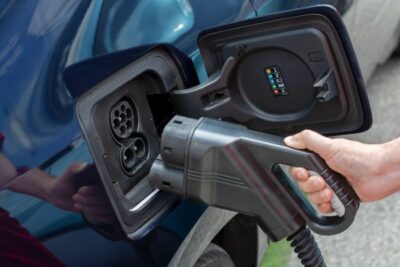Charging cables are one of the most critical components of the EV charging infrastructure. The type of charging cable you select will impact your vehicle’s charging speed, range, and overall charging experience.
But, with so many options on the market, it can be challenging to determine which one is right for you. That’s why we’ve decided to delve into the world of EV charging cables and explore the different types available, as well as factors you should consider when shopping for a charging cable.
Ready to learn more? Let’s dive in!
Table of Contents
A Comprehensive Overview of EV Charging Cable Types
There are several different EV charger cable types, each with its specific use and characteristics. Here are some of the most common types:
1. Type 1 (J1772) Cable
A Type 1 (J1772) charging cable is standard for electric vehicles in North America and Japan. It is a rectangular-shaped plug with five pins that are used to transmit power, control signals, and communication between the vehicle and the charging station.
A Type 1 charging cable can deliver up to 240 volts of AC power, with a maximum charging rate of 6-7 kW. It is typically used for Level 1 and Level 2 charging, which refers to charging at lower power levels for longer periods, such as overnight charging at home.
2. Type 2 (Mennekes) Cable
A Type 2 (Mennekes) charging cable is a European standard cable used for EVs in Europe and other regions. It has a seven-pin connector that plugs into the vehicle’s charging port and a Type 2 connector that plugs into a charging station.
A Type 2 charging cable can deliver up to 43 kW of power, making it suitable for Level 1, Level 2, and DC fast charging.
3. CCS (Combined Charging System) Cable
A CCS charging cable combines AC and DC charging capabilities. It has a Type 2 connector, which is used for AC charging, and an additional two DC pins, which are used for DC fast charging.
The CCS charging standard was developed to provide a universal charging solution for electric vehicles, focusing on compatibility and interoperability between different manufacturers’ charging equipment and vehicles.
CCS charging cables deliver up to 350 kW of power, making them suitable for fast charging at public charging stations. They are becoming more common in Europe and North America, with many new EV models featuring CCS compatibility.
4. CHAdeMO Cables
CHAdeMO is a fast-charging cable for electric vehicles, mainly used in Japan and other Asian markets. It uses a unique connector with six pins, unlike other charging standards such as Type 1, Type 2, and CCS. The CHAdeMO charging cable delivers up to 62.5 kW of power, making it suitable for fast charging at public charging stations.
It can charge compatible electric vehicles up to 80% in as little as 30 minutes, depending on the battery capacity of the vehicle. While CHAdeMO is primarily used in Japan and other Asian markets, it is also available at some charging stations in Europe and North America.
Things to Keep in Mind When Choosing an EV Charging Cable
When choosing an EV charging cable, there are several factors that you should consider to ensure you select the right one for your needs. Here are some things to keep in mind:
1. Compatibility
Check the connector type of your EV and ensure that it matches the connector of the charging cable you want to buy. Different EV models and manufacturers may use different connector types, so it’s crucial to double-check compatibility before making a purchase.
2. Charging Speed
To identify the highest charging rate your electric vehicle can accommodate, it’s essential to review its charging specifications. This will help you select a cable that matches that speed, allowing you to charge your car as quickly as possible.
Using a charging cable with a lower max speed than your EV’s single-phase speed will limit how quickly you can charge your car. On the other hand, using a cable with a higher max speed won’t increase your charging speed beyond your EV’s limit.
3. Length
The length of your EV charging cable will depend on several factors, such as the location of your charging point and the distance between your parking space and the charger. Generally, 7.5 meters is a good length that can reach most charging points comfortably while still being easy to handle and store.
Although longer cables may be more inconvenient to store, they offer greater flexibility regarding where you can charge your car, which can be especially useful if you frequently use different charging locations.
4. Durability
Look for a charging cable that is made from high-quality materials and is built to last. The cable should be able to withstand the wear and tear of regular use and should be resistant to different types of damage.
5. Price
Charging cables are available at different price points. Consider your budget, but also remember that investing in a high-quality charging cable can save you money in the long run by preventing the need for frequent replacements.
Are EV Charging Cables a Necessity?
While some public charging stations may have cables available, it is not always guaranteed. You may find yourself in a situation where you need to charge your vehicle, but there is no available cable.
A charging cable will allow you to charge your vehicle wherever there is a compatible charging station. Also, consider whether the charging stations in your area primarily use tethered or untethered charging stations.
Tethered vs. Untethered Charging Stations
Tethered charging stations are those that have a built-in cable permanently attached to the unit, and users must use this cable to charge their electric vehicles.
Untethered charging stations, on the other hand, have no permanently attached cable, and users need to bring their charging cable to plug into the station. Tethered charging stations are more common in public charging infrastructure, while untethered ones are more common for home charging setups.
Although you may not need a charging cable if you solely depend on tethered charging stations, it is wise to keep one handy as a backup plan. For example, you might travel to a different location where tethered charging stations are unavailable.
Maximize Your EV’s Potential With The Right Charging Cable
With the right charging cable in hand, you can confidently take on long road trips, make the most of public charging infrastructure, and fully enjoy the benefits of owning an electric vehicle.
So, why wait any further? Follow our advice to get the right gear and enjoy a smooth driving experience in your eco-friendly ride!










Comments on " EV Charging Cables 101: Understanding Your Options" :